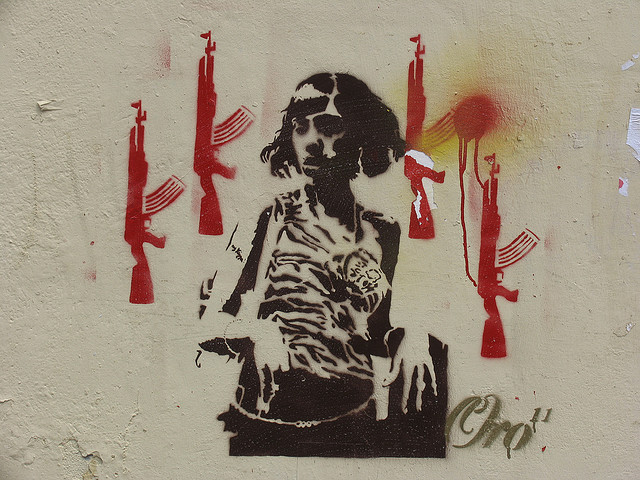Social media has been alive with chatter about the finalised UN Sustainable Development Goals (SDGs) and how they might influence security and development policy globally. To us, there’s no better example of the need to link security and sustainable development policy than in the South Pacific. Experience in the Pacific (PDF) shows that even a small number of illicit weapons can have a disproportionate impact on the development of small developing nations.
Expectations of the SDGs are capturing the public imagination in more ways than their predecessors, the Millennium Development Goals (MDGs), ever could. At the same time as the SDGs are prepared for implementation in 2016, the Arms Trade Treaty (ATT), which came into force in December 2014, convened its first Conference of State Parties in August.
The opportunity to link security and development policy in order to build and preserve peaceful societies for flourishing sustainable development in the Pacific has never been riper.
The SDGs and the Treaty have a lot in common. We’ve seen this at the recent UN First Committee on Disarmament, in which a number of states have drawn attention to the links between disarmament and development. More specifically, many states and civil society groups welcomed SDG 16.4 on reducing arms flows and called for its strong implementation.
After the failure of many conflict and violence-ridden states to achieve the MDGs, it’s justified that their successors include peace-building as a priority for sustainable development. Lessons learned about the relationship between weapons proliferation, conflict and sustainable development are being streamlined into SDG 16.
It’s increasingly recognised that arms facilitate, escalate and prolong conflict. People are displaced, heathcare is burdened, while schools, hospitals and markets become inaccessible. On a national scale, insecure investment environments cause outward capital flow and dissuade tourism.
Examples of how arms proliferation affects development include the Solomon Islands conflict, which led to a 25% reduction in GDP, while Papua New Guinea’s 2013 National Security Policy (PDF) found that ‘transnational crimes are currently rated by law enforcement agencies as [the] single biggest threat to national security’. According to a World Bank study, poor law and order deters private enterprises from further investment.
While the Pacific has witnessed the impact of armed violence on social and economic development, the region is also an example of the benefits of disarmament and arms control. Following a string of military coups, tribal and ethnic violence, rising armed crime and gun homicide, the region collectively undertook efforts to disarm Pacific communities. Instead of rushing in more guns to restore law and order, and generally to create a safe environment for recovery to proceed, firearms were actually seen as the most immediate impediment to economic recovery.
Weapons exporters of the region have also played their part. Australia stopped exports to Papua New Guinea, which created a shortage of bullets among mercenary gunmen, while New Zealand denied an export permit to ship ammunition to a Vanuatu gun dealer for fear of fueling ethnic violence in the Solomon Islands.
The Pacific consensus on arms control has meant the region has avoided the ‘AK47 plague’ and large-scale atrocities witnessed in other regions. Now 12 out of 16 Pacific Islands Forum nations are patrolled by unarmed police and ten have no military.
Solomon Islands, once flooded with weapons, is now in law a gun-free nation. The UNDP found that peace and security in Solomon Islands was a precondition for development to occur. After the major plunge in national income during conflict, a sense of security has allowed per capita GDP (PDF) to slowly make a comeback.
The implementation of the ATT is an important preventive measure for Pacific countries, including Australia, with comparatively low levels of arms proliferation, as it is for states with significant violence.
If a lack of arms regulation in the Pacific were to create a conspicuous gap in the global anti-trafficking net, the region would become more attractive as a base or transit region for irresponsible and illicit arms dealers. That would increase the risk of transnational crime, armed violence, conflict and terrorism. A strong, universally implemented ATT could sharply curtail these risks.
Efforts don’t need to be duplicated. Working towards the SDGs is enhanced by ratifying and implementing the ATT. The ATT is the first legally binding treaty with the primary purpose of creating accountability and transparency for the US$100 billion arms trade. It’s plausible to see how Goal 16—which is about transparent, responsible and accountable institutions—will set the mandate, while the ATT becomes one of its facilitators.
Transparency created through regulating arms transfers strengthens a state to act responsibly as an international member, particularly when there’s reasonable suspicion that trade will breach UN Security Council embargoes or end-use will result in grave violations of the Geneva Convention. The Treaty is thus vital to achieving SDG 16 precisely because shadowy arms trade undermined achievement of the MDGs.
The ATT is the best placed instrument to help build on SDG 16 and bring about effective change. With the announcement of $400,000 towards ATT ratification, Australia is half way there. Now a link to SDG 16 and a push for transparent and accountable ATT implementation is essential. Composing the SDGs is a significant litmus test of global ambition, hopes and willpower. Therefore, in attempting to build a new world, one with more peaceful societies, concrete mechanisms such as the ATT ought to be the stable and loyal companion of its genesis.


